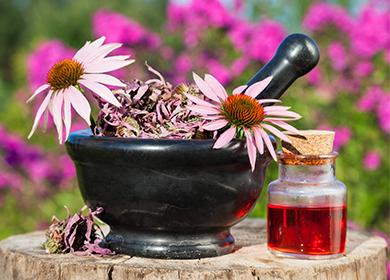The content of the article
Modern medicine ambiguously interprets the healing properties and contraindications of Echinacea. The plant belongs to the group often used in folk medicine for the treatment of colds and SARS. But application for this purpose cannot be considered justified.
Features of Echinacea purpurea
The plant belongs to the genus Echinacea, which includes at least ten types of crops. The medicinal products include purple, lanceolate, as well as white coneflower. The most studied purple, which often becomes the object of scientific research, is used as part of medicines.
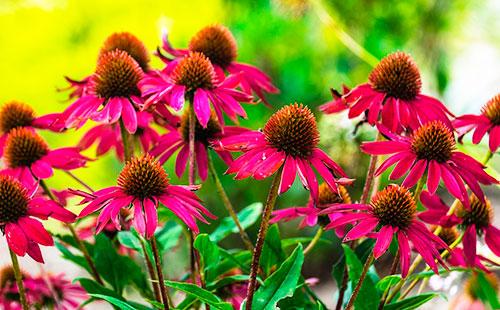
Description
Echinacea is a magnificent flower that can decorate every park and front garden. It reaches one meter in height, and rushes straight up on slender, straight and slightly rough stems.
The root system is small, short, but well developed, is an interweaving of many thin roots. Only one stem always grows from the root, on which leaves are periodically and rather rarely located.
At the ground, they are large, oval, sharply tapering both to the stem and to the other end. They sit on long stalks, often bend over and lie down on the ground, serrated and carved along the edge. As the stem grows, the size of the leaves decreases. The upper leaflets are small, sit alternately, lanceolate, with a rough surface.
During flowering, Echinacea purple conquers with beauty. Each stalk is crowned with a large flower basket, the diameter of which reaches fifteen centimeters. Long serrated sheets on the edge of a purple-pink color. Having barely opened, they look up, but as they bloom, they sink and border the stem. In the center of the inflorescence are small tubular flowers. They are directed upwards, grow in length by no more than four centimeters and are painted in dark red.
The culture blooms in July and maintains color until the end of August. Propagated by seeds that form at the end of flowering.
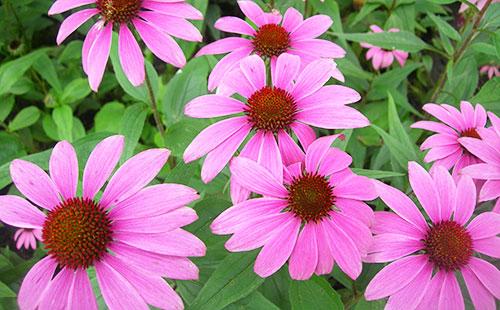
Geography and distribution
The native land of the plant is North America, from where magnificent flowers in the seventeenth century came to Europe, and then to the territory of modern Russia. Echinacea was grown exclusively for decorative purposes. As such, it is bred in gardens and parks, where the medicinal plant is perfectly adjacent to other flowering crops.
In the late nineties in Russia, the first plantations for the cultivation of echinacea for industrial purposes were organized. The first farm began work in the Samara region, the second is located in the Krasnodar Territory, in the North Caucasus. The production meets the needs of the pharmaceutical industry, which uses plant materials for the manufacture of echinacea preparations.
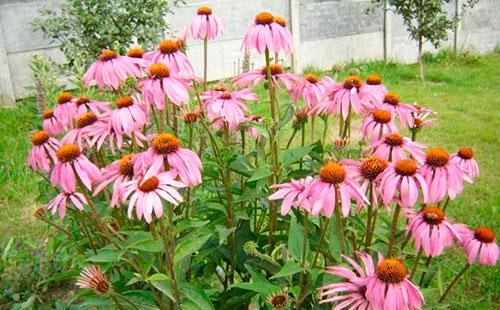
Cultivation
In summer cottages, flowers are grown as ornamental plants and for the purpose of independent procurement of raw materials. Echinacea is propagated by seeds, which are planted in February in a greenhouse or in wooden boxes with fertile soil.For the development of seeds, heat and plentiful watering are required, they germinate within five weeks. Strong seedlings are planted in open ground, the best time for this is the warm days of May.
The plant is demanding on the quality of the soil. It should be fertilized, with the addition of lime and compost, sufficiently moistened, with full drainage. Preferred are sunny areas where powerful bushes grow. When planting in the soil, you can organize raised beds, where the plants will be more comfortable. The distance between adjacent bushes should be at least twenty-five centimeters.
Rooted in the ground, Echinacea bothers the gardener little. It is resistant to pests and diseases, develops well with regular watering and weeding of weeds. But after heavy rains it becomes susceptible to viral diseases, for the fight against which fungicides should be used. Otherwise, the disease deforms the stems and leaves, inflorescences develop sluggishly and look inferior.
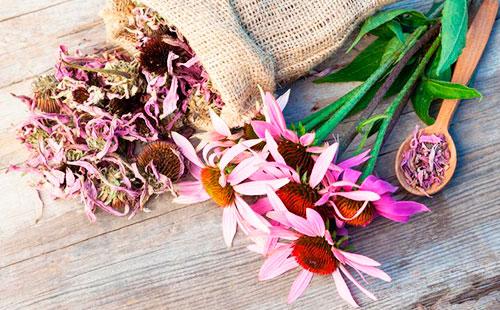
Collection and Harvesting
Echinacea purpurea grass and its root part have therapeutic value. Raw materials are not harvested simultaneously. Bushes break out well from the soil, as the root system is compact.
- Flowers, stems. Cut with a knife or secateurs during the period of active flowering, usually in July. Stacked under canopies in a well-ventilated shady room. Dry until the inflorescences become hard, leathery, and the stems are brittle.
- Rhizome. Harvested in September. They are cleaned of soil particles, washed, dried in the same way as flowers. As it dries, the roots become stiff and thin. Dried raw materials can be crushed and put in linen bags for storage, placing them in a dry, ventilated place.
Harvesting medicinal raw materials is recommended annually. According to reviews, echinacea quickly loses its healing properties during storage.
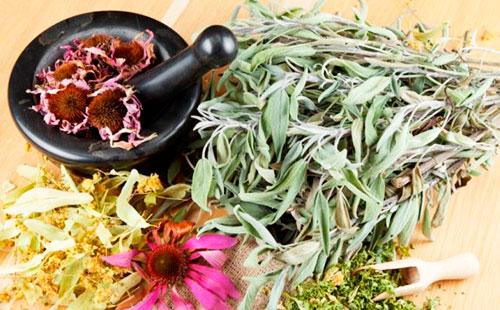
Composition and properties
Flowers of a medicinal plant are traditionally used in different countries of the world. But in most countries, use is based on traditional medicine knowledge not supported by scientific evidence. So the culture is traditional for the indigenous peoples of America. According to archaeological expeditions, it has been used by the people of the American continent for more than four hundred years.
The main contribution to the study of the properties and composition of the plant was made by German scientists. It was here that the overwhelming majority of studies were conducted that made it possible to systematize existing data on flower culture.
In modern Russia, interest in it is also growing. It is connected with the fact that the bulk of Echinacea preparations presented in the pharmacy network comes to the country from abroad and is expensive. With their own raw materials base, scientists hope to develop the production of medicines based on purple coneflower in Russia.
According to research, the composition of the herbal and root parts of plants is not uniform.
- Grass. Active active ingredients are polysaccharides and hydroxycinnamic acids. According to researchers, they have a stimulating effect on the functioning of the immune system. It is manifested by the synthesis of interferon and interleukin, which increases overall immunity when taken orally and localized when used externally.
- Root. The root portion has a high concentration of essential oils, inulin, glucose and resins. In Germany, this combination of natural ingredients is recognized as effective in the fight against febrile conditions, it is recommended to brew roots with influenza, SARS.
Specialists of the Samara State University in 2010 conducted a study of the composition of the herbal part of the medicinal plant. The following substances were isolated from the samples collected at the industrial harvesting sites of the culture.
- Phenylpropanoids. Derivatives of cinnamic acids with immunomodulatory effects. Provided with chicory, coffee and chlorogenic acids.
- Polysaccharides. Substances exhibiting antiviral activity stimulate immunity.
- Alkylamides. Natural compounds with anti-inflammatory effect.
Flavanoids are identified in the composition of the herb, which to date remain the least studied components of echinacea. In a study by scientists at Samara State University, nicotiflorin and rutin were first added to the list of famous flavanoids to quercetin and kempferol. These substances affect the structure of soft tissues and mucous membranes, have a regenerating effect.
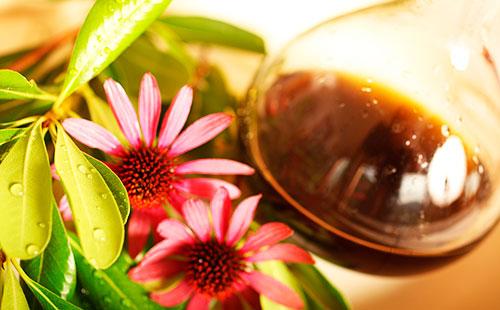
The use of a medicinal plant
What diseases will Echinacea help get rid of? Only in recent years, the composition and therapeutic properties of echinacea have been formulated quite fully. In part, they confirmed the adequacy of its use in traditional medicine. New qualities of herbal remedies, in particular, adaptogenic and antidepressant properties, have also been identified.
Natural adaptogen
Adaptogenic plants are called cultures, drugs from which are able to increase the body's resistance to stress factors. It is known that stress as a result of exposure to the external environment (increased noise, radiation, infectious pollution) causes a decrease in the immune response, which causes diseases.
The study of the adaptogenic properties of Echinacea purpurea has been carried out repeatedly. So in 2007, evidence was presented to increase the resistance of experimental mice to radiation exposure when taking plant extract.
In 2010, plant extract was used to treat chickens infected with the H5N1 virus. Its immunomodulatory effect is fixed. In 2013, the results of studies on mice with toxic liver damage and concomitant therapy with echinacea appeared. The protective effect of the drug on the kidneys and liver was revealed, restoring the work of the adrenal glands.
One of the newest studies was conducted in 2014 by specialists from the Gorno-Taiga station named after V. Komarova of the Russian Academy of Sciences. During the study, mice were exposed to stress factors: noise, active movement. It was found that tincture of Echinacea purpurea increases the body resistance (resistance) by twenty percent, stimulates the metabolism in the liver, which typically reduces the intensity in a stressful situation. The drug eliminates depletion of glycogen, ATP.
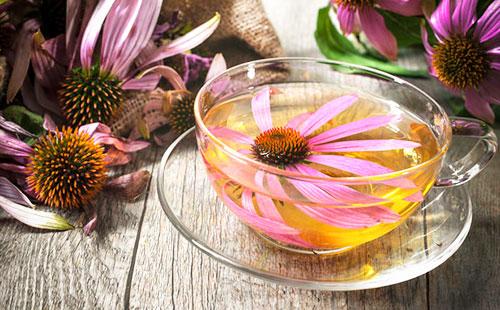
Cold remedy
What does Echinacea cure? Most often, Echinacea is used for immunity, according to doctors, tablets and alcohol tincture are the most common tool used at home for the prevention and treatment of acute respiratory viral infections, influenza. Echinacea tea and the addition of inflorescences and herbs are also used.
In Germany, the plant is included in official medical practice. It is recommended to use it as a painkiller and anti-inflammatory agent for sore throat, fever, cough. Tincture is used to prevent diseases of a viral nature. The drug is similarly used in the USA and Russia, but there is no reliable data on how effective echinacea for the common cold is.
The fact is that in various sources the results of studies with completely different results are presented. Some indicate that taking this remedy during an illness helps to alleviate the condition. In one study, in which ninety-five patients with early symptoms of the common cold took part, there was an improvement in the condition of those who used Echinacea tea five days earlier than those who did not.
Other clinical trials have found that taking echinacea reduces the risk of developing colds by fifty-eight percent, and reduces the fever with a fever from four to one day.
But this data is not accepted by the entire scientific community. A number of experts believe that there are too many weaknesses in the conclusions of clinical trials, and the analysis is not reliable.
In 2014, the Cochrane Collaboration specialists decided to put an end to the dispute about the effectiveness of herbal remedies for colds. This international non-profit organization unites about thirty thousand scientists working in one hundred and thirty countries of the world. Scientists conduct independent studies of the effectiveness of various medications and publish reports on the official portal.
A group of scientists from the Cochrane Collaboration examined the effectiveness of echinacea drugs on the market in Europe and America. The results of twenty-four controlled trials, in which 4,631 people took part, were also analyzed. Echinacea remedies were used for the prevention and treatment of viral, colds.
Based on the analysis by an international group of scientists, the main conclusions are made.
- The results of controlled studies cannot be considered completely reliable. Of the twenty-four studies, five are identified with a high risk of bias. Five more are recognized with a high risk of bias. The results of eight studies, it was decided not to take into account due to the obvious bias of their organizers.
- The effect of treating colds with echinacea is weak. The clinical effect obtained during objective studies was only a fraction of a percent different from placebo. The tests did not show a statistically significant result in reducing the period of the disease.
- Confirmed minor preventive effect. A tendency towards a decrease in susceptibility to colds and viral diseases with a prophylactic intake has been identified.
- The effect of different products based on echinacea is very different. Scientists have made this crucial conclusion by examining the composition of several dozen products. The vast majority of drugs have not been tested during clinical trials, the presence of echinacea extract in some of them has not been confirmed. The quality of raw materials varies, which affects the quality and action of the drug.
- Side effects are likely. Among the possible side effects are allergic reactions with varying degrees of intensity. In some cases, a rash has been recorded in young children.
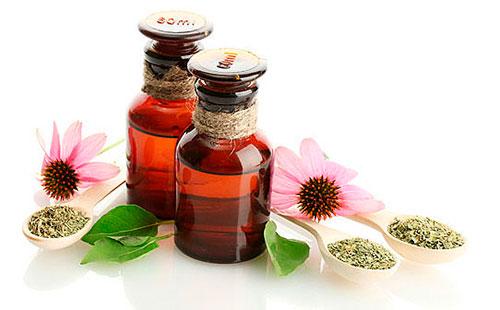
Tincture for depression, rheumatism
The medicinal plant has adaptogenic properties, therefore, it can be used for minor manifestations of psychological disorders, to combat stress, sexual impotence.
- Place the roots of a plant weighing 100 grams in a glass bowl.
- Pour alcohol with a strength of 70 percent, a volume of one liter.
- Insist for seven days in a dark place, periodically shaking.
Take with depressions three times a day, 2-30 drops.
The same tincture should be used to treat rheumatism. Inside, take 25 drops three times a day before meals.Outwardly used for wet compresses: 60 drops per 100 milliliters of saline. The compress is applied in a warm form to the affected joints.
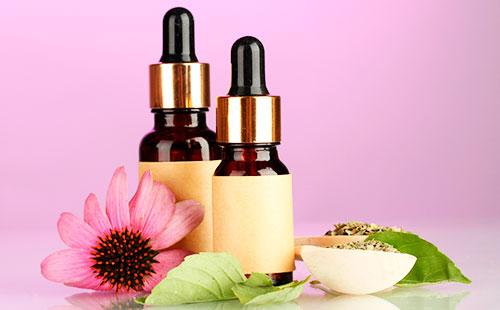
Water infusion of roots
The tool improves the productivity of wound healing, effective in the treatment of inflamed wounds, purulent ulcers, boils, in the presence of burns, pressure sores.
- Grind the dried roots, use a tablespoon of raw materials.
- Place in an enameled container, pour hot water with a volume of 300 milliliters.
- Strain in a water bath for 30 minutes, pass through cheesecloth.
Inside, take the infusion three to four times a day, two tablespoons on an empty stomach. Apply externally to a clean cotton cloth and apply to affected areas of the skin.
Water infusion of flowers
According to reviews, echinacea for children and adults can be used as a painkiller for viral, inflammatory diseases. It increases the activity of phagocytes, stimulates the restoration of tissues and mucous membranes.
- Grind flower baskets, use a tablespoon of raw materials.
- Pour boiling water with a volume of 250 milliliters.
- Leave to brew for one hour.
Take in a warm form, one third of a glass three times a day.
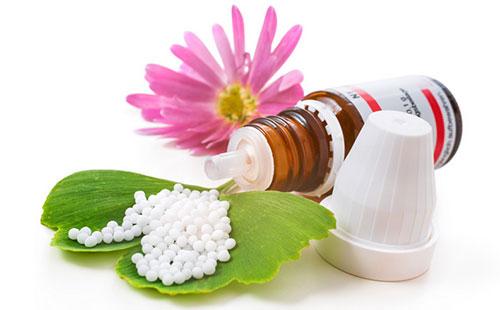
Advice
What is echinacea officinalis? Echinacea purpurea has no contraindications, except for probable allergic reactions. During pregnancy and lactation, administration is not recommended, although there is no evidence that the drug increases the risk of congenital abnormalities of the fetus or worsens the health status of the woman. The recommendation is associated with a lack of scientific basis, since no studies have been conducted on the effects on the mother and child.
When admission should be guided by the recommendations of specialists. In the official recommendations of the medical center of the University of Maryland (USA), the need to use only alcohol-free drugs for children is noted.
Adults can use alcohol tincture, water infusion for the general strengthening of the immune system in the season of colds, as well as infections of the upper respiratory tract and genitourinary system. Reception continues up to ten days three times a day. They use drugs on an empty stomach, drinking plenty of water.
In the presence of poorly healing, wetting wounds, compresses with water infusion or ointments based on echinacea should be used.
Echinacea purpurea is a popular treatment for the treatment and prevention of colds. But recent studies show the inefficiency of its use in the treatment of acute respiratory viral infections, colds and only a small preventive effect. The plant can be used as an adaptogen to increase stress resistance of the body, in the complex treatment of inflammatory diseases and for the treatment of skin injuries.
